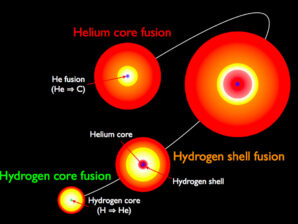Red giants are dying stars, in advanced stages of stellar evolution, which have depleted the hydrogen in their cores. In this work1, published today in Nature Communications, a team2 of astronomers mainly from Instituto de Astrofísica e Ciências do Espaço (IA3), have found new evidence that red giant stars experience “glitches” – sharp structural variations – in their inner core.
Unfortunately, it is impossible to look directly inside a star. However, a technique dubbed asteroseismology4, which measures oscillations similar to “earthquakes” in stars, can provide indirect glimpses of stellar interiors. The “glitches” can affect these oscillations, or the frequencies and paths of gravity and sound waves traveling through the stellar interior.
IA researcher Margarida Cunha explains: “Waves propagating inside stars induce minute stellar brightness variations that can be detected with highly precise space-based instruments. These waves reveal the conditions of the medium where they propagate, which is to say, the physical properties of the stellar interiors”.
“This work presents the first characterization of structural discontinuities present in the core of red-giant stars, therefore allowing, for the first time, to precisely sound the physical processes occurring in this region”.
Mathieu Vrard
The team used data from the Kepler space telescope (NASA) to detect and study waves propagating to the deepest layers of evolved stars. Lead author Mathieu Vrard, who began this work at IA, but is currently a postdoctoral research associate in astronomy at the Ohio State University, adds: “By analyzing these variations, we can obtain not only the global parameters of the star, but also information on the precise structure of these objects”.
Low-mass red giants experiencing helium burning in their cores are often used in astrophysical studies as probes of distance, to measure aspects like galaxy density, and to learn more about the physical processes behind stellar chemical evolution. So it’s vital that scientists model them correctly which, in turn, requires that they understand why these discontinuities happen.

In this work the team analyzed a sample of 359 red giants that were below a certain stellar mass, measuring various properties and individual oscillation frequencies of each star. They discovered that almost 7% of these stars exhibit structural discontinuities.
There are two main theories which explain how these disturbances might work. The first states that “glitches” are present throughout the star’s evolution, but are generally very weak and below the threshold for what astronomers would categorize as a true discontinuity.
The second suggests that these irregularities are “smoothed out” by some unknown physical process that later leads to changes in the structure of the star’s core.
As it turns out, the first scenario is not supported by this study, but more precise data is needed before scientists can confidently subscribe to the second. Diego Bossini (IA) explains: “This study shows the limits of our models and it gives us an opportunity to find a way for improving them”.
Notes
- The article “Evidence of structural discontinuities in the inner core of red-giant stars”, was published today in Nature Communications (DOI: 10.1038/s41467-022-34986-z).
- The team is: Mathieu Vrard, Margarida S. Cunha, Diego Bossini, Pedro P. Avelino, Enrico Corsaro & Benoît Mosser.
- The Instituto de Astrofísica e Ciências do Espaço (Institute of Astrophysics and Space Sciences – IA) is the reference Portuguese research unit in this field, integrating researchers from the University of Lisbon, the University of Coimbra and the University of Porto, and encompasses most of the field’s national scientific output. It was evaluated as “Excellent” in the last evaluation of research and development units undertaken by Fundação para a Ciência e Tecnologia (FCT). IA’s activity is funded by national and international funds, including FCT/MCES (UIDB/04434/2020 e UIDP/04434/2020).
- Asteroseismology is the study of stellar interiors, by measuring seismic oscillations at the star’s surface. In seismology, the different vibration modes from an earthquake can be used to study the Earth’s interior, in order to get data from the composition and depth of its different layers. In a similar fashion, oscillations at the star’s surface can be used to infer its internal structure and composition.
Contacts
Margarida Cunha, Mathieu Vrard
Science Communication Group
Ricardo Cardoso Reis; Sérgio Pereira; Filipe Pires (coordenação, Porto); João Retrê (coordenação, Lisboa)


